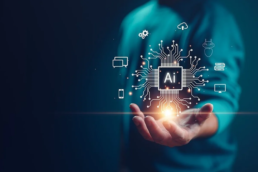As we move deeper into the digital age, the integration of Artificial Intelligence (AI) into enterprise SaaS (Software as a Service) platforms is becoming a critical driver of business transformation. AI’s ability to analyze vast amounts of data, learn from patterns, and make autonomous decisions is unlocking new possibilities for businesses. This article explores the emerging trends and innovations in AI for enterprise SaaS that are shaping the future.
Trend 1: Hyperautomation
Hyperautomation involves the use of advanced technologies, including AI and machine learning, to automate complex business processes end-to-end. Unlike traditional automation, which focuses on automating specific tasks, hyperautomation aims to create a fully automated enterprise environment.
Example: Gartner predicts that by 2024, organizations will lower operational costs by 30% by combining hyperautomation technologies with redesigned operational processes. Companies like IBM and Microsoft are at the forefront, offering AI-driven automation solutions that integrate seamlessly with existing SaaS platforms.
Trend 2: AI-Enhanced Cybersecurity
As cyber threats become more sophisticated, AI is playing a crucial role in enhancing cybersecurity measures. AI-powered security tools can detect and respond to threats in real-time, providing a proactive approach to protecting sensitive data and systems.
Example: Darktrace, an AI cybersecurity company, uses machine learning to identify unusual patterns in network traffic, helping organizations like T-Mobile and Rakuten prevent cyber-attacks. According to a report by Capgemini, 61% of organizations say they cannot detect breach attempts today without the use of AI technologies.
Trend 3: Personalized Customer Experiences
AI is enabling a new level of personalization in customer experiences. By analyzing customer data and behavior, AI algorithms can deliver highly customized interactions, improving satisfaction and loyalty.
Example: Salesforce’s AI tool, Einstein, helps businesses personalize customer interactions by predicting customer needs and recommending next-best actions. This level of personalization has led to significant improvements in customer engagement and conversion rates for many businesses.
Trend 4: Advanced Predictive Analytics
Predictive analytics is becoming increasingly sophisticated with the integration of AI. These advanced analytics tools can forecast future trends, customer behaviors, and potential risks, allowing businesses to make proactive decisions.
Example: Netflix uses AI-driven predictive analytics to recommend content to users based on their viewing history. This has not only enhanced user satisfaction but also increased viewing time, contributing to Netflix’s success.
Trend 5: Integration of AI with IoT
The convergence of AI and the Internet of Things (IoT) is creating smarter, more connected systems. AI algorithms analyze data from IoT devices to optimize operations, predict maintenance needs, and improve decision-making.
Example: General Electric (GE) integrates AI with IoT to monitor and predict equipment performance in its Predix platform. This integration helps GE reduce maintenance costs and improve operational efficiency.
Trend 6: Explainable AI (XAI)
As AI models become more complex, there is a growing need for transparency in how these models make decisions. Explainable AI (XAI) aims to make AI decision-making processes more understandable to humans, ensuring trust and accountability.
Example: IBM’s Watson is working on developing XAI capabilities to provide clearer insights into how AI models arrive at their conclusions. This is particularly important in industries like healthcare and finance, where understanding AI decisions is critical.
Trend 7: AI-Powered Financial Management
AI is transforming financial management by automating tasks such as budgeting, forecasting, and compliance. AI-driven financial tools provide real-time insights and enhance accuracy, helping businesses manage their finances more effectively.
Example: BlackLine uses AI to automate accounting processes, reduce errors, and ensure compliance. This has enabled companies like Coca-Cola to streamline their financial operations and improve reporting accuracy.
Conclusion
The integration of AI into enterprise SaaS is driving significant advancements across various business functions. From hyperautomation and enhanced cybersecurity to personalized customer experiences and predictive analytics, AI is revolutionizing how businesses operate. By staying abreast of these emerging trends and innovations, organizations can leverage AI to achieve greater efficiency, innovation, and competitive advantage.
As AI technology continues to evolve, its impact on enterprise SaaS will only grow, creating new opportunities for businesses to thrive in the digital era. Embrace these trends to stay ahead of the curve and unlock the full potential of AI in your SaaS platform.




